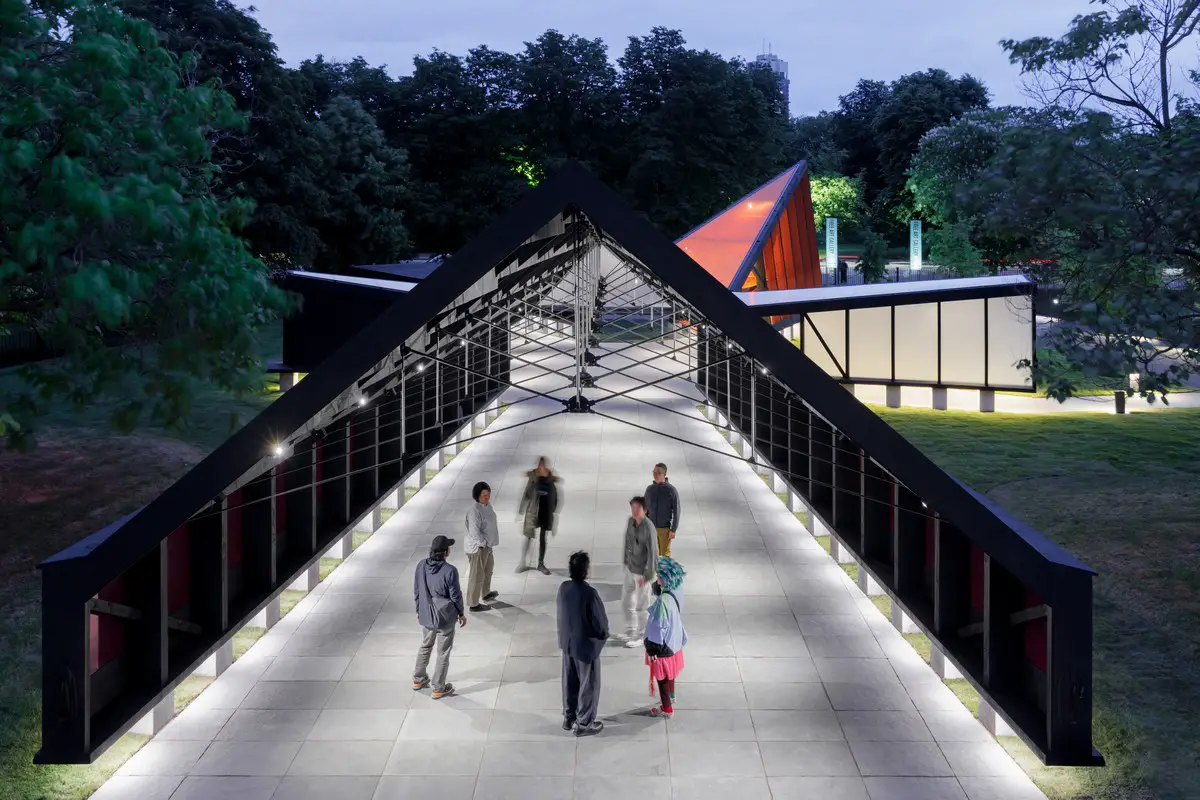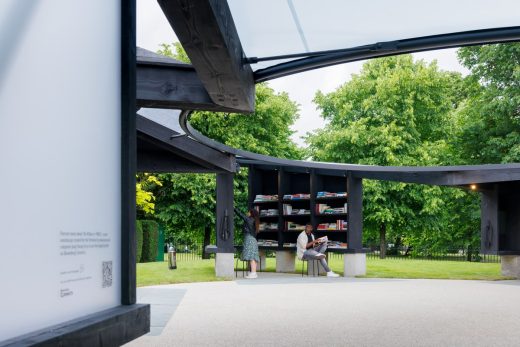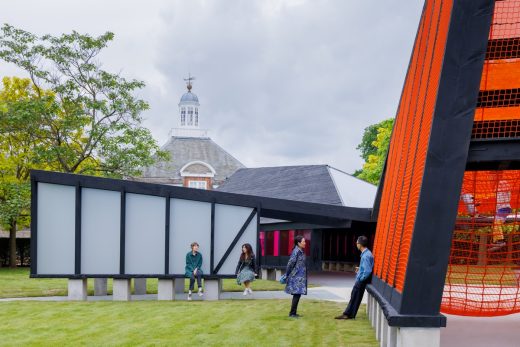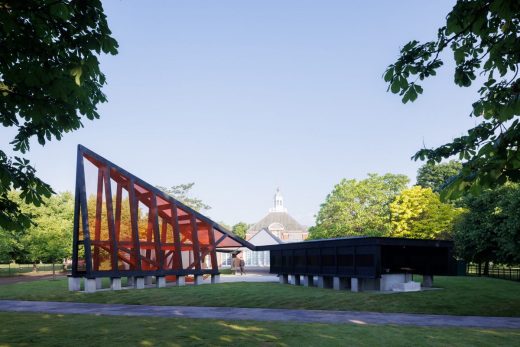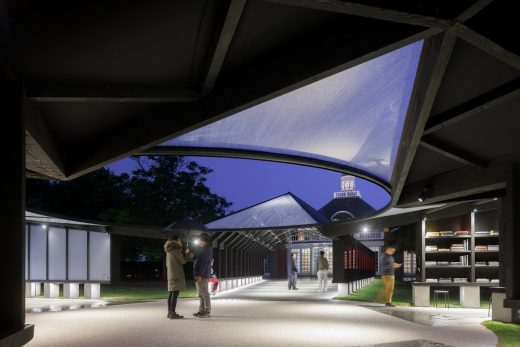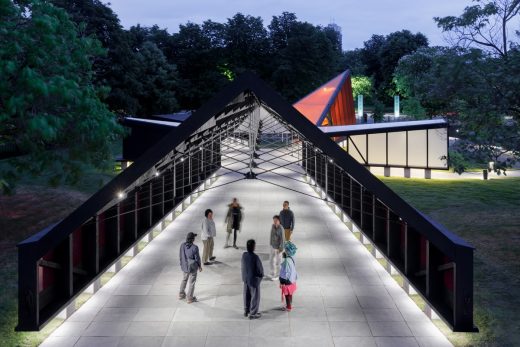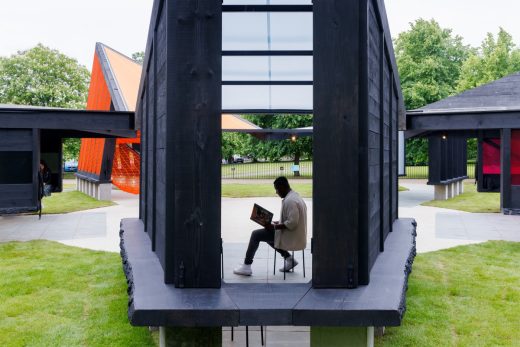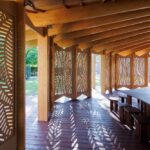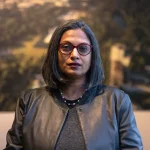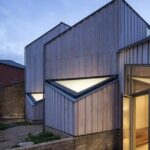23rd Serpentine Pavilion 2024 by architect Minsuk Cho, West London architecture news, England architectural project pictures
23rd Serpentine Pavilion in London
Updated 5 June + 16 May 2024
Design: architect Minsuk Cho
Location: Kensington Gardens, West London, UK
The 23rd Serpentine Pavilion, Archipelagic Void, designed by Seoul-based Korean architect Minsuk Cho and his firm Mass Studies opens to the public on 7 June 2024, with Goldman Sachs supporting the annual project for the 10th consecutive year.
Serpentine Pavilion 2024, Archipelagic Void, designed by Minsuk Cho, Mass Studies © Mass Studies Photos: Iwan Baan Courtesy: Serpentine
Serpentine 23rd Pavilion, London
New details revealed for 23rd Serpentine Pavilion designed by Minsuk Cho
Featuring a specially commissioned soundscape and The Library of Unread Books alongside a vibrant programme of live events
Sponsored by Goldman Sachs
Serpentine Pavilion 2024 designed by Minsuk Cho, Mass Studies. Design render, view of void from the Gallery and Play Tower:
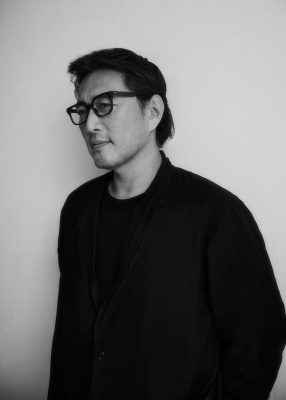
Minsuk Cho, Mass Studies © Photo by Mok Jungwook
Launching a season of specially curated activations, the 23rd Serpentine Pavilion will play host to a new commissioned soundscape, a library and a series of performances and talks.
Comprised of five ‘islands’, each structure of the Pavilion is unique in size, form, name and purpose, providing a multifaceted platform for Serpentine’s live programme from June to October.
As the main entry to the Pavilion, the Gallery will play host to a six-channel sound installation created by musician and composer Jang Young-Gyu, presenting The Willow is <버들은> in the Summer and Moonlight <월정명> in the Autumn. Taking inspiration from the surrounding environment of the Pavilion, Jang incorporates sounds from nature and human activities recorded in Kensington Gardens with traditional Korean vocal music and instruments. The distinctive tones and melodies trace the changing of seasons. They respond to the constantly transforming landscape and ecology of the Park.
The Library of Unread Books by artist Heman Chong and archivist Renée Staal will be located in the north of the Pavilion. Conceived as an artwork that functions as a ‘living’ reference library, each book has been donated by its previous owner to form a pool of common knowledge. Visitors are welcome to contribute and submit an unread book in their possession to the growing collection. By making these titles accessible, The Library of Unread Books functions as a collective gesture, addressing notions of access and distribution.
In a nod to the history of the Serpentine building the Tea House will be located to the east of the Pavilion. Designed by James Grey West, the Serpentine South building opened in 1934 and originally functioned as a teahouse until the early 1960s, before reopening as an art gallery in 1970.
Providing a space for outdoor play, the Pavilion also features the Play Tower, a pyramid structure fitted with a bright orange netscape for visitors to climb and interact.
To the west, is the Auditorium, the largest structure of the five ‘islands’. With benches built into its inner walls, this space will provide an area for public gathering, performances and talks.
Starting on Friday 7 June, Minsuk Cho will be in conversation with Serpentine Artistic Director Hans Ulrich Obrist to discuss the inspirations behind this year’s Pavilion, Cho’s approach to architecture and the history of the commission.
The Serpentine Pavilion 2024 will also become a platform for Serpentine’s Park Nights, the annual interdisciplinary platform for live encounters in music, poetry, performance, and dance that will see artists create brand new site-specific works.
Serpentine will present a performance by artist, choreographer and dancer Eun-Me Ahn in June to commence the programme.
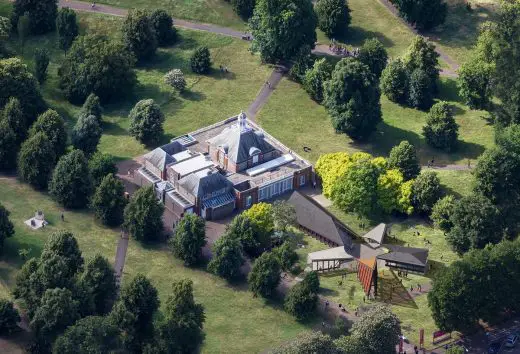
photo © Mass Studies Courtesy: Serpentine
In July, Serpentine Arts Technologies will host a day of events exploring the relationship of technology, property, and ecology. Visitors will be invited to become stewards of a collective artwork initiated by Tomás Saraceno and his long-term collaborators, the communities of Salinas Grandes in Jujuy, Argentina. Titled Fairclouds, this unique project builds connections between the cycles of water, information and life. By purchasing a partial common ownership licence and becoming part of an international network of stewards, audiences will support the work of indigenous communities in Argentina. The project is part of an ongoing collaboration between Serpentine Arts Technologies, RadicalxChange and Aerocene Foundation.
Minsuk Cho, Architect, Mass Studies, said: “We are honoured and grateful to unveil Archipelagic Void in June. To realise the Pavilion, we began by asking what can be uncovered and added to the Serpentine site, which has already featured over twenty historical iterations at the centre of the lawn, from a roster of great architects and artists. To approach this new chapter differently, instead of viewing it as a carte blanche, we embraced the challenge of considering the many existing peripheral elements while exploring the centre as a void. It also begins to address the history of the Serpentine Pavilion. By inverting the centre as a void, we shift our architectural focus away from the built centre of the past, facilitating new possibilities and narratives.”
Bettina Korek, Chief Executive, and Hans Ulrich Obrist, Artistic Director, Serpentine, said: “Mass Studies’s Serpentine pavilion led by Minsuk Cho is another exciting step forward for this singular commission that has pushed the boundaries of creative experimentation with architecture. We’re thrilled that Archipelagic Void will expand on Serpentine’s evolving history as a site for bringing people together in the park, and our continued mission of building bridges between art and audiences. We are deeply grateful to our loyal partners for sustaining the Pavilion each year and look forward to a summer full of experiences made possible by Cho’s brilliant complex for encounters and collaboration.”
Richard Gnodde, Chief Executive Officer, Goldman Sachs International said: “We are delighted to have collaborated with Serpentine for ten consecutive years on the iconic architectural Pavilion commission. Through the years, the project has attracted a diverse group of architects who have showcased their talents and shared their unique global perspectives. This year, we are looking forward to celebrating Minsuk Cho and his firm Mass Studies. Cho’s design is entirely unique and promises to be a vibrant and fascinating space for us all to enjoy. We extend our sincere gratitude to the Serpentine team and all the supporting partners who collectively continue to make this project a reality. As part of Serpentine’s mission to remain free and open to all, once again, every Kensington Gardens visitor will have the opportunity to engage with this remarkable project.”
Jon Leach, Director at AECOM said: “It is a privilege to collaborate with Serpentine for AECOM’s twelfth year as Technical Advisor and our third year as Project Manager. Every year the project pushes the boundaries of what is possible in architecture, design, driving spontaneity, innovation and creativity to realise the architects’ unique visions. This year’s design by Minsuk Cho and Mass Studies showcases the use of natural timber with a combination of modern and traditional joinery techniques. Its five independent spaces will create a variety of experiences for the public to enjoy.”
Tim Leigh, Managing Director of Stage One Creative Services said: “This is the fifteenth Serpentine Pavilion we have constructed for Serpentine. The Pavilions are an enchanting commission, and it is remarkable how each scheme brings its own character and challenges. This year’s design is very heavily influenced by architectural and cultural references from South Korea and this has provided us with an opportunity to develop a craft that combines traditional joinery with advanced machining of timber. Each year is an architectural experiment. And Mass Studies have imagined what I’m sure will become an iconic design.”
A catalogue designed by South Korean Seoul-based designers Sulki and Min will accompany the Pavilion. Bringing together contributors from across the world of architecture, art and poetry, all of which inform Cho’s architectural practice, the publication will feature newly commissioned texts including Kenneth Frampton, architect, writer and former Ware Professor of Architecture at the Graduate School of Architecture, Planning and Preservation, Columbia University; Alex Taek-Gwang Lee, professor of cultural studies and founding director of the Centre for Technology in Humanities, Kyung Hee University; Beatrice Galilee, writer, curator and co-founder of The World Around; Renée Green, artist, writer and filmmaker and Kim Hyesoon, award-winning poet, essayist and critic. The catalogue will also include a conversation between Minsuk Cho and Artistic Director Hans Ulrich Obrist, alongside a visual exploration of the design and research materials of this year’s commission.
The Serpentine Pavilion commission, which began in 2000 with Dame Zaha Hadid, has been awarded to some of the most significant names and emerging talents in international architecture. The Pavilion has evolved over the years as a participatory public and artistic platform for the Serpentine’s pioneering, interdisciplinary, community and education programmes.
This year’s Pavilion selection was made by Serpentine CEO Bettina Korek, Artistic Director Hans Ulrich Obrist, Director of Construction and Special Projects Julie Burnell, Director of Curatorial Affairs and Public Practice Yesomi Umolu, Project Curator Alexa Chow and Curator at Large, Architecture & Site Specific Projects Natalia Grabowska together with advisors Sou Fujimoto and David Glover.
The Pavilion is supported by Goldman Sachs.
Mass Studies was founded in 2003 by Minsuk Cho in Seoul, Korea, as a critical investigation of architecture in the context of mass production, intensely over-populated urban conditions, and other emergent cultural niches that define contemporary society. Amid the many frictions defining spatial conditions in the twenty-first century, namely past vs. future, local vs. global, utopia vs. reality, and individual vs. collective, Mass Studies focuses on the operative complexity of these multiple conditions instead of striving for a singular, unified perspective. For each architectural project, which exists across a wide range of scales, Mass Studies explores issues such as spatial systems, building materials/techniques, and typological divergences to foster a vision that allows the discovery of new socio-cultural potential.
Minsuk Cho was born in Seoul and graduated from the Architectural Engineering Department of Yonsei University (Seoul, Korea) and the Graduate School of Architecture at Columbia University (New York, USA). After working in various firms, including OMA Rotterdam, he established Cho Slade Architecture in 1998 in New York City with partner James Slade. In 2003, he returned to Korea to open his own firm, Mass Studies.
Cho has garnered numerous accolades over the course of his career. Notable among these achievements are his first prize win in the 1994 Shinkenchiku International Residential Architecture Competition and the Architectural League of New York’s Young Architects Award in 2000 for his contributions at Cho Slade Architecture. He also received two U.S. Progressive Architecture Awards (Citations) in 1999 and 2003. His work with Mass Studies earned two nominations for the International Highrise Award (Deutsches Architekturmuseum-DAM), once as a finalist in 2008 for Boutique Monaco and again in 2010 for S-Trenue. The Korea Pavilion at the World Expo 2010 Shanghai was honoured with the Silver Award in the “Pavilion Design” category from the Bureau of International Expositions, accompanied by a Presidential Citation from the Korean government. Cho co-curated the exhibition Named Design at the Gwangju Design Biennale 2011, in collaboration with Anthony Fontenot under the direction of Seung H-Sang and Ai Weiwei. In June 2014, Minsuk Cho received the prestigious Golden Lion Award for the Best National Pavilion while serving as the commissioner and co-curator of the Korean Pavilion at the 14th International Architecture Exhibition la Biennale di Venezia. Cho was recognised further by receiving the Hwagwan Medal Order of Cultural Merit from the Korean government.
Mass Studies works have been presented in various exhibitions, including the Venice Architecture Biennale in 2004 and 2010, the Vitra Museum travelling exhibition Open House from 2006 to 2008, and a solo show titled Before/After: Mass Studies Does Architecture at the PLATEAU Samsung Museum of Art in Seoul in 2014. Mass Studies’ architectural designs and presentations are part of the collections and archives of the MoMA (New York), DAM (Frankfurt), Art Institute Chicago (Chicago), and the Mokchon Architecture Archive (Seoul). Additionally, the 5th edition of Kenneth Frampton’s canonical Modern Architecture: A Critical History (2020, Thames & Hudson) highlights Cho and his work in the added South Korea chapter. Minsuk Cho is also an active lecturer and speaker, participating in symposia worldwide.
Representative works include the Pixel House, Missing Matrix, Bundle Matrix, Shanghai Expo 2010: Korea Pavilion, Daum Space.1, Tea Stone/Innisfree, Southcape, Dome-ino, Daejeon University Residential College, Space K Seoul Museum, Pace Gallery Seoul, Choru and the Won Buddhism Wonnam Temple. Current in-progress projects include the new Seoul Film Center (Montage 4:5), Danginri Culture Power Plant (Danginri Podium and Promenade), Yang-dong District Main Street (Sowol Forest), and the Yeonhui Public Housing Complex. Recently completed projects include the restoration and extension of the French Embassy in Korea, the renovation and extension of the Osulloc Tea Museum, and the Osulloc Green Tea Factory.
Jang Young-Gyu is a musician and composer and has worked with musical groups such as Uhuhboo Project, Be-Being, and SsingSsing. He is currently a member of the band Leenalchi. Based in South Korea, his work seeks to create unconventional forms and techniques through exploring Korea’s musical heritage in contemporary music. Jang composed music for visual narratives and has provided scores for various South Korean blockbuster films and drama series such as The Foul King (2000), Sympathy for Mr. Vengeance (2002), The Coast Guard (2002), Tazza: The High Rollers (2006), Train to Busan (2016), The Wailing (2016), and Alienoid (2022).
In addition, Jang’s work also extends to the realms for theatre, dance and art. Jang is a long-time collaborator to and has provided music for the performances of South Korean choreographer Eun-Me Ahn including Dancing Grandmothers and Dragons.
Heman Chong is an artist whose work is located at the intersection between image, performance, situations and writing. His practice can be read as an imagining, interrogation and sometimes intervention into infrastructure as an everyday medium of politics. He is currently working on solo shows at UCCA Dune (2024), Singapore Art Museum (2025) and Tai Kwun (2026).
Renée Staal is a Singapore-based collection manager. She has worked at art institutions and architecture practices in Singapore, the Netherlands and the United States. Together, they co-founded The Library of Unread Books in 2016.
Additional reference:
The Archipelago Conversations, Édouard Glissant, Hans Ulrich Obrist, iisolarii, 2022 (Sixth Edition) inspiring Minsuk Cho: “The purpose of architecture has always been to show, to claim space, and the monument is proof of that. Perhaps in our world today, our archipelagic world of relation and rhizomes, the basis and the role of architecture will no longer be to show the monument, but to show the invisible. The aesthetic of the invisible brings us back to the aesthetic of the void and the infinite, which need not produce anguish, but hope. That could be the new ambition of architecture.”
Serpentine Pavilion
This pioneering commission, which began in 2000 with Dame Zaha Hadid, has presented the first UK structures by some of the biggest names in international architecture. The Pavilion is realised with the support of technical advisors AECOM. In recent years it has grown into a highly anticipated showcase for emerging talents, from Sumayya Vally, Counterspace (South Africa), the youngest architect to be commissioned, and Frida Escobedo (Mexico), to Diébédo Francis Kéré (Burkina Faso) and Bjarke Ingels (Denmark). In 2022, Black Chapel was designed by Theaster Gates (US) and in 2023 À table was designed by Lina Ghotmeh (France and Lebanon).
The Goldman Sachs Group, Inc. is a leading global financial institution that delivers a broad range of financial services across investment banking, securities, investment management and consumer banking to a large and diversified client base that includes corporations, financial institutions, governments and individuals. Founded in 1869, the firm is headquartered in New York and maintains offices in all major financial centres around the world.
The Samsung Foundation of Culture was founded in 1965 based on the philosophy of sharing by Ho-Am Byung-chull Lee, the founder of Samsung. Since then, the foundation has been promoting Korea’s diverse culture and actively supporting cultural exchanges with other countries, recognising that culture and the arts are driving force for national development as they improve the quality of life of individuals and resolve social conflicts and pathologies.
The foundation operates the Leeum Museum of Art and Ho-Am Museum of Art, and leads the specialisation and globalisation of art programmes through partnership with many art institutions worldwide.
The Korea Foundation (KF) is a non-profit organisation affiliated with the Korean Ministry of Foreign Affairs and supported by public funding and private donations. The KF was established in 1991 for the purpose of enhancing Korea’s image throughout the world and fostering global friendship by implementing various exchange programs. Its public diplomacy efforts are carried out in three primary ways: Support for Korean Studies Overseas, Global Networking, and Cultural Exchange.
AECOM is the world’s trusted infrastructure consulting firm, delivering professional services throughout the project lifecycle – from advisory, planning, design and engineering to programme and construction management. On projects spanning transportation, buildings, water, new energy, and the environment, our public- and private-sector clients trust us to solve their most complex challenges. Our teams are driven by a common purpose to deliver a better world through our unrivalled technical and digital expertise, a culture of equity, diversity and inclusion, and a commitment to environmental, social and governance priorities. AECOM is a Fortune 500 firm and its Professional Services business had revenue of $14.4 billion in fiscal year 2023.
Stage One Creative Services is a manufacturing and engineering company that delivers high-end projects for the creative industries. From ceremonies and live events to entertainment and architecture, the company’s work creates moments that people remember forever. Stage One has delivered work in more than 46 different countries, from the London 2012 Olympic Games opening ceremony to the World Cup opening ceremony in Qatar, its project portfolio includes Ed Sheeran’s Mathematics Tour, The Hive and set pieces for The Brits. Stage One is proud to be associated with the Serpentine Pavilion and has constructed every Serpentine Pavilion since 2009.
About Serpentine
Building new connections between artists and audiences, Serpentine presents pioneering contemporary art exhibitions and cultural events with a legacy that stretches back over half a century, from a wide range of emerging practitioners to the most internationally recognised artists, writers, scientists, thinkers, and cultural thought leaders of our time.
Based in London’s Kensington Gardens, across two sites, Serpentine North and Serpentine South, Serpentine features a year-round, free programme of exhibitions, architectural showcases, education, live events and technological activations, in the Park and beyond the gallery walls.
The public art programme has emerged as a central strand of Serpentine’s work with artists who are constantly expanding the possibilities of what public art could be today. Major presentations include a collection of Eduardo Paolozzi’s sculptures (1987), Anish Kapoor’s Turning the World Upside Down (2010), Lee Ufan’s Relatum – Stage (2018-19), Christo and Jeanne-Claude’s London Mastaba in the Serpentine Lake (2018), I LOVE YOU EARTH by Yoko Ono (2021) and Dominique Gonzalez-Foerster In remembrance of the coming alien (Alienor), (2022).
Proud to maintain free access for all visitors, thanks to its unique location, Serpentine also reaches an exceptionally broad audience and maintains a profound connection with its local community.
On view at Serpentine
Yinka Shonibare CBE: Suspended States | 12 April – 1 September 2024
The artist’s first London solo exhibition in over 20 years interrogates the ecological impact of colonialisation, imperialism’s legacy on conflict and consequential attempts at peace.
Judy Chicago: Revelations | 23 May – 1 September 2024
Presenting the first major interdisciplinary, immersive institutional exhibition in London of Judy Chicago. Focused on drawing, it will bring together new and little-seen works, preparatory studies alongside audio, visual and new technology materials.
Gerhard Richter, STRIP-TOWER (2023) | 25 April – 27 October 2024
This new large-scale work by one of the most significant artists living today is the latest in a long-standing series of significant public presentations in The Royal Parks since Serpentine’s foundation in 1970.
Atta Kwami, DzidzƆ kple amenuveve (Joy and Grace), 2021-22 | Until 1 September 2024
The mural embodies Kwami’s vibrant palette and abstract painting style. It characteristically plays with the colour and form improvisations that are distinctive of Ghanaian architecture and African strip-woven textiles, especially kente, made famous by the Ewe and Asante people of Ghana.
Open Tuesday – Sunday
10am – 6pm
020 7402 6075
information@serpentinegalleries.org
https://www.serpentinegalleries.org/
Image credit: Serpentine Pavilion 2024 designed by Minsuk Cho, Mass Studies. Design render, view of void from the Gallery and Play Tower. Photo © Mass Studies, Courtesy: Serpentine
23rd Serpentine Pavilion, London images / information received 160524
Location: Kensington Gardens, London, W2 3XA, England, UK
Previously on e-architect:
5 Jul 2019
Serpentine Pavilion Designs
Serpentine Pavilion 2019
Architect: Junya Ishigam
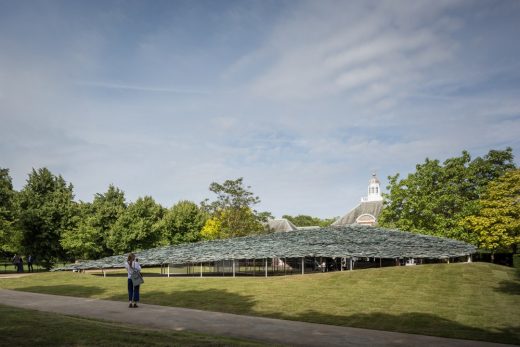
photo © Ste Murray
Serpentine Gallery Pavilion 2019
London Architecture
Contemporary Architecture in London
London Architecture Links – chronological list
London Architecture Walking Tours
Serpentine Pavilion London Architecture
Serpentine Pavilion Designs Archive
Serpentine Gallery Pavilion 2018 design by architect Frida Escobedo:
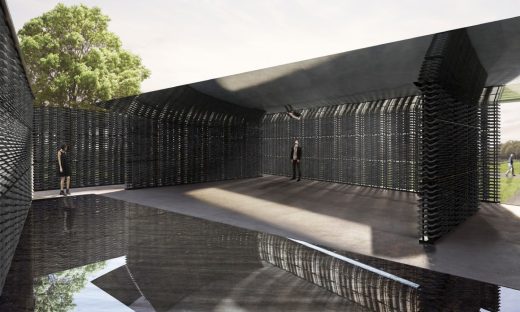
image © Frida Escobedo, Taller de Arquitectura, Rendering by Atmósfera
Serpentine Gallery Pavilion 2015
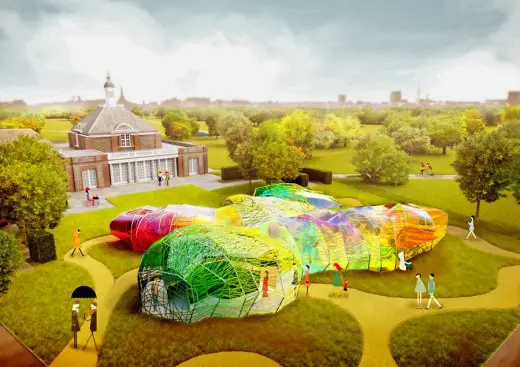
photo © Steven Kevin Howson / SelgasCano
Four Summer Houses in the Serpentine 2016 Programme
Serpentine Pavilion 2007 original architect : Snøhetta
Serpentine Pavilion architect 2006 : Rem Koolhaas / OMA
Serpentine Pavilion architect 2005 : Álvaro Siza & Eduardo Souto de Moura
Serpentine Pavilion architect 2003 : Oscar Niemeyer
Serpentine Pavilion architect 2002 : Toyo Ito
Serpentine Pavilion architect 2001 : Daniel Libeskind
Serpentine Pavilion architect 2000 : Zaha Hadid Architects
Comments / photos for the 23rd Serpentine Pavilion 2024 in London designed by Lina Ghotmeh page welcome

